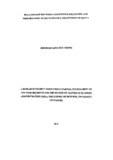| dc.description.abstract | Strategic management ensures organizational performance by creating and shaping effective strategy to outwit competition. The primary objective of microfinance is to maximize the performance overtime leading to profitability. Superior performance can be achieved in a competitive industry through pursuit of generic strategies. The Microfinance sector has given rise to many institutions which are competing for the same market. This has demanded that microfinance institutions which are competing for the same market. This has demanded that microfinance institutions formulate and implement competitive strategies to be able to cope with the competitive pressure. Following the changes in the environment, microfinance institutions have been forced to come up with competitive strategies that will deal with forces in the environment in order to gain a competitive advantage in terms of performance. The current operational set-up in Kenya’s microfinance industry is a turbulent one and highly competitive market condition. This study therefore aimed at determining the relationship between competitive strategies and performance of MFI in Kenya. The choice of strategies by these institutions has determined the direction of the Microfinance institutions and their performance. The study used a survey to collect data. Data was collected from Microfinance firms. The list was distributed to senior managers and operation managers of MFI institutions whose positions and roles gave them the ability to respond effectively to the questions. To achieve the research objectives, the respondents were issued with a number of competitive strategies and were required to score on a 5 point likert scale the extent to which respective microfinance institutions use those strategies and if they affected their performance. The population of the study consisted of 61 MFI in the AMF ASSOCIATION AT 31ST August 2014. Out of 61 targeted, 45 responded by returning the filled questionnaires. This was approximately 74% response rate. Responses through the questionnaires were then tabulated, coded and processed by use of a computer programme- statistical package for social Science (SPSS) VERSION 21. Descriptive statistics such as mean and standard deviation were used. Tables and charts were used to present responses and facilitate comparison. Linear and multiple correlation analysis was used to examine the relationship between independent variables (Firm performance). The study found that, cost leadership strategies, differentiation strategies and focus strategies have effect on performance of microfinanace in Kenya. | |

